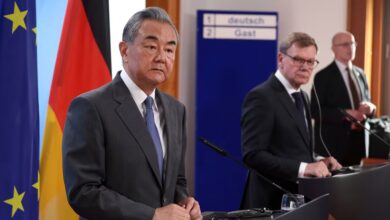
The European Union is ready to extend Brexit’s post-divorce transition period by a year to allow more time to find a trade deal, diplomats said Wednesday ahead of a difficult summit.
Prime Minister Theresa may is due in Brussels later in the day to address the other 27 EU leaders on the stalled negotiations towards a divorce deal to bring Britain out of the Union.
Talks are at an impasse over the issue of a legal backstop to keep the border between Northern Ireland and the Irish Republic open after the UK leaves the bloc on march 29 — but EU negotiator Michel Barnier has an idea.
According to two European diplomats, Barnier is ready to add a year to the 21-month post Brexit transition period — taking it to the end of 2021 — to provide more space to strike a trade deal.
This offer would not in itself resolve the back-stop issue, which must be settled in the Brexit treaty that must be ratified before March to avoid a damaging “no deal” scenarios.
But the extension would grant more time to agree a new EU-UK trade relationship and avoid the need for separate plans for Northern Ireland, which London staunchly opposes.
The diplomats said that Barnier had revealed his offer to EU ministers at a meeting in Luxembourg on Wednesday.
With the offer on the table, Europe is seeking to put pressure on May to come to Brussels with ideas of her own.
“I am going to ask Prime Minister May whether she has concrete proposals on how to break the impasse,” EU president Donald Tusk declared.
But May, hemmed in by opponents in her own party and even in her own cabinet, has no such proposals.
– Tricky divorce –
The choreography of Wednesday’s summit opening emphasizes British isolation.
May will meet one-on-one with Tusk at 17:45 (1545 GMT) before briefing her 27 European colleagues, but then the rest of the EU leaders will leave to discuss Brexit over dinner without her.
Tusk has made it clear that if May and EU negotiator Michel Barnier do not offer signs of concrete progress towards a draft deal he will not call a November summit to sign it.
Instead, the whole circus could either be pushed back to December or — more dramatically — the EU could use the November weekend to meet on preparations for a “no-deal” Brexit.
Previously, both sides had agreed that Britain crashing out of the Union on March 29 next year with neither a divorce agreement nor a road-map to future ties would be an economic and diplomatic disaster.
But, after Britain’s refusal to accept an indefinite legal “backstop” to prevent the return of a hard border between Northern Ireland and the Irish Republic, doubts are mounting.
“I think we are quite close to a no-deal,” warned Konrad Szymanski, the Polish minister for European Affairs after a pre-summit meeting with his European counterparts in Luxembourg.
Back in Brussels, a stern Tusk said he had “no grounds for optimism” based on a report Tuesday from Barnier and May’s appearance in parliament on Monday.
The main disagreement between London and Brussels is over how to keep the Irish border open after Brexit, but May is also fighting with her own MPs, who must ultimately approve the final divorce deal.
At a three-hour cabinet meeting on Tuesday morning, which included ministers with reservations about her strategy, May said a deal was possible if they all stood together.
“I’m convinced that if we as a government stand together and stand firm, we can achieve this,” she said, according to her spokesman.
– No deal plans –
Addressing MPs in the House of Commons on Monday, May had said a deal was “achievable” while sticking to her principles on the Irish border issue.
But a senior European official said the speech had only underscored for Barnier the uphill struggle he faces to get an agreement.
To solve the Irish question, Britain has proposed staying aligned to the EU’s customs rules until a wider trade deal can be signed that avoids the need for any frontier checks.
But her own euroskeptic Conservative MPs are demanding this “backstop” arrangement be time-limited, something the EU will not accept.
May said the EU was also insisting on its own “backstop” in case the London proposal did not work, which would see Northern Ireland alone stay aligned to the customs union and single market.
She says this would threaten the integrity of the United Kingdom — and it is strongly opposed by her Northern Irish allies from the Democratic Unionist Party (DUP).
Economists fear “no deal” Brexit would greatly disrupt trade, travel and manufacturers’ supply chains in Europe, push Britain into recession and even have global consequences.
On Tuesday, the chairman of the US Federal Reserve Jerome Powell warned that a “disorderly Brexit” would slow the EU economy as a whole and have a knock-on effect on US banks.




